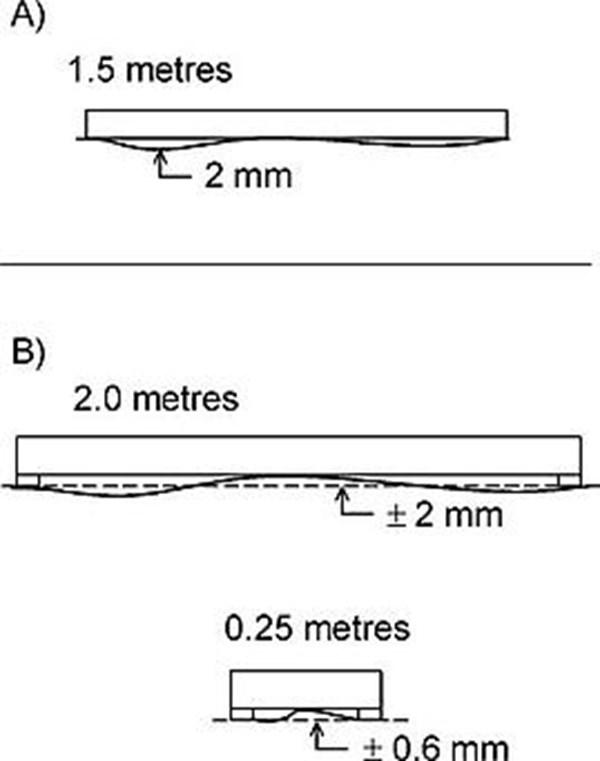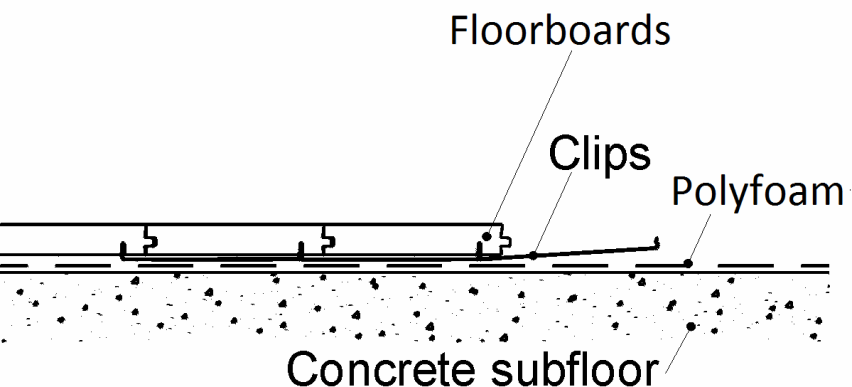GENERAL INFORMATION FOR JUNCKERS CLIP SYSTEM
Solid Hardwood Flooring | Commercial / Residential
C 1.1
Fig. 1
C 1.0 General information
C 1.1 Clip System Information
C 1.1.1 Specifier's Information
C 1.1.2 Laying Instructions
INTRODUCTION
This information describes the general conditions for and specification of Junckers Clip System for residential and commercial use.
The Clip System consists of solid 2-strip boards or planks which are laid with metal clips over an underlay or resilient intermediate layer which gives good walking comfort and step-sound reduction properties
SUBFLOOR
The subfloor can be of concrete, lightweight concrete, screed and wooden materials.
Wooden subfloors of chipboard, MDF, plywood or floorboards fixed to battens or joists mustbe of sufficient inherent stiffness with a load bearing strength which is adequate for the use ofand the expected load on the floor. The moisture content of wooden subfloors must be inbalance with the relative humidity of the room, i.e. 6-12% moisture content (UK).
If several types of subfloor make up the same floorspace, the subfloor must be of uniform elasticity and flatness, to ensure that the final floor is uniform.
Fig. 2

FLATNESS OF SUBFLOOR
Before intermediate layers are laid the subfloor must be levelled so that any deviations in theflatness do not conflict with the requirements of one of the two methods stated below, see Fig. 2.
A) Traditional straight edge
The subfloor must be flat with a maximum deviation of 2 mm under a 1.5 m straight edge (UK: 3 mm under a 2 m straight edge). The surface must be smooth. Any minor irregularities must be corrected.
B) Straight edge with supports
The subfloor must be flat with a maximum deviation of ± 2 mm under a 2 m straight edge (2mm supports). The surface must be smooth. Any minor irregularities, e.g. across day joints, must be corrected so that the maximum localised deviation from flat level is ± 0.6 mm under a 0.25 m straight edge (0.6 mm supports).
Major irregularities on concrete floors can be corrected by using a self-levelling compound.Wooden subfloors may be levelled by sanding or installing hard fibreboards, possibly combined with filler, or by laying fibrous plasterboards.
Junckers Technical Information specifies the flat level requirements of subfloors as a maximum deviation of 2 mm under a 1.5 m straight edge (UK: 3 mm under a 2 m straight edge).
INTERMEDIATE LAYER
The intermediate layer must ensure good walking comfort and step-sound reduction properties. The stiffness of the intermediate layer must be adjusted to avoid too much movement underfoot, furniture movement, etc. due to excessive deflection when walking on the floor.
Moisture conditions, requirements of thermal insulation and any adjustment of the height of the floor structure are crucial to the final choice of intermediate layer. The sections "Thermal insulation" and "Moisture protection" specify a number of products as follows:
- Junckers PolyFoam - a step-sound reducing underlay incorporating a moisture barrier. JunckersFoam - a step-sound reducing underlay.
- Floor cardboard, 500 g/m²
- Flooring grade Polystyrene with densities of 30/40 kg/m³, depending on board thickness and load, see C 1.1.1.
MOISTURE PROTECTION
Concrete and screeded subfloors
At ground level as well as upper floor levels protection against residual moisture in the concrete/subfloor is required and controlled by laying Junckers PolyFoam on the surface of the concrete, see Fig. 3. On ground level this also protect against radon penetration.
The PolyFoam has to be turned up at walls till upper edge of the floor. The residual moisture contained in the concrete or screed must not exceed 90% RH (UK:Concrete moisture max. 75% RH acc. to BS 8201, when checked by measurement).
Where polystyrene boards are laid and there is a risk of moisture seeping up from below, a moisture barrier, 0.20 mm PE membrane or 1000 g Polythene, is laid on the polystyrene board.
Wooden subfloors
junckersFoam is used as an inter-mediate layer directly on the wooden subfloor, see Fig. 4.
On wooden subfloors above ventilation spaces Junckers PolyFoam can be used as an intermediate layer, providing that the space is ventilated effectively to the outdoors and that the underside of the insulating layer is open to diffusion. If the ventilation space is damp, a moisture barrier must be laid, e.g. 0.20 mm PE membrane on the floor of the ventilationspace, see Fig. 5.
Fig. 3

Fig. 4

Fig. 5

THERMAL INSULATION
Floating floor structures provide good conditions for thermal insulation with an intermediate layer of polystyrene. The subfloor for polystyrene can be of concrete or wooden materials. See "Moisture protection"ard.
EXPANSION GAPS AND -JOINTS
Perimeter expansion gaps at walls and fixed installations are specified in the Specifier's Information for the floor system, see C 1.1.1.
To minimize the movements in the floor caused by fluctuations in the climatic conditions in the building, it will, for large commercial floors, be necessary to build in expansion joints. The expected climatic conditions will decide the actual dividing of the flooring. Contact Junckers Technical Service for advice.
Fig. 6
SPECIAL CLIMATIC CONDITIONS
The relative humidity in office build-ings, shops and similar can deviate from that in residential buildings, thus requiring a different clip size.
CLIPS
Clips are available in different sizes according to various air humidity ranges. The clip size is selected primarily on the basis of the expected maximum relative humidity in the building during the course of the year. However, in order to minimize the overall movements of larger floors it may be necessary to choose a larger clip than that corresponding to the expected maximum RH, see Table 1 and Fig. 6.
For shipsdecking always use 3-hole clips (129.8 mm).
For Junckers 20,5 x 140mm planks and Boulevard planks, 20.5 x 185 mm, always use 2-hole clips (129.4 mm) or larger.
| Clip type (label colour) | Humidity range [%] | Clip size | Gaps between boards when installed |
| 0-hole (white)* | 10-40** | 128.8 mm | depends on job-site conditions* |
| 1-hole (green) | 25-55** | 129.1 mm | 0.1 mm |
| 2-hole (yellow) | 40-65 | 129.4 mm | 0.4 mm |
| 2½-hole (Black) | 55-75 | 129.6 mm | 0.6 mm |
| 3-hole (red) | 65-85 | 129.8 mm | 0.8 mm |
| 4-hole (Orange) | 75-95 | 130.2 mm | 1.2 mm |
*This clip type is used in arctic- and desert areas. Acclimating of the wood prior to installation is necessary.
**In a very dry environment there will be some larger permanent gaps between the floorboards. Specifiers are advised to contact Junckers Technical department if such conditions are anticipated. With all clip sizes there will always be gaps when the relative humidity falls to, or below, the lower end of the recommended range.
Number of clips required for 14 and 22 mm 2-strip:
Residential: 13 clips/m2 (clip spacing 700 mm).
Commercial: 17 clips/m2 (clip spacing 500 mm).
Number of clips required for 15 and 20.5 mm Plank, residential and commercial:
15 x 129 mm: 17 clips/m2 (clip spacing 500 mm).
20.5 x 140 mm: 16 clips/m2 (clip spacing 500 mm).
20.5 x 185 mm: 13 clips/m2 (clip spacing 500 mm).
Number of clips required for Shipsdecking, residential and commercial:
129 mm board width: 17 clips/m2 (clip spacing 500 mm).
20.5 x 140 mm: 16 clips/m2 (clip spacing 500 mm).
20.5 x 185 mm: 13 clips/m2 (clip spacing 500 mm)
